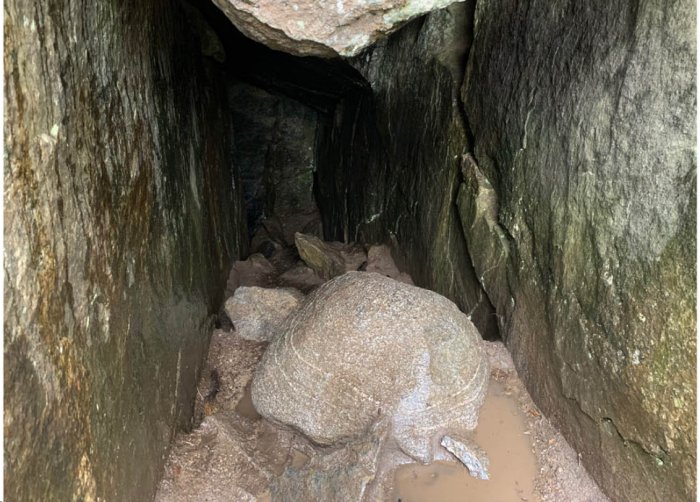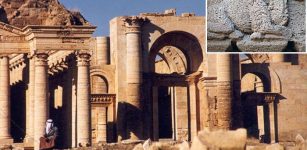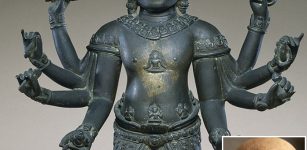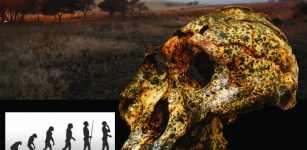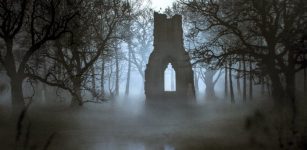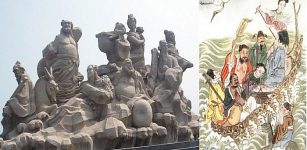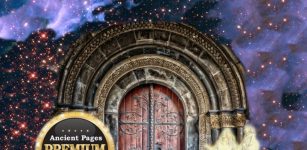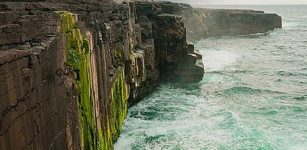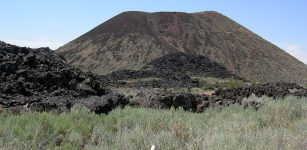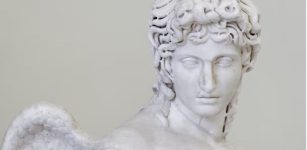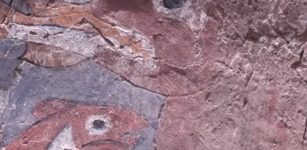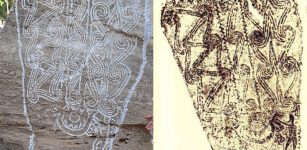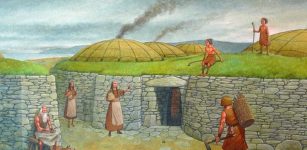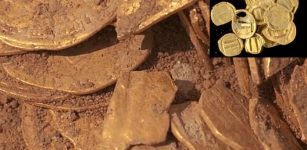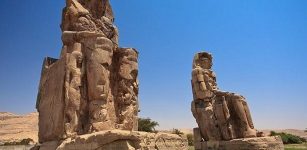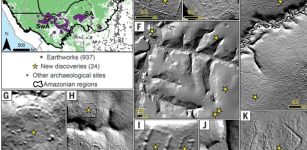Why Did Sages And Shamans Repeatedly Visit The Mysterious Finnish Pirunkirkko Cave (Devil’s Church)?
Conny Waters - AncientPages.com - In folklore, the famous 34-meter-long crevice cave known as Pirunkirkko, or Devil's Church in English, was known as a place where local sages would meet to contact the spirit world.
The national park of Koli in eastern Finland, the Pirunkirkko cave, is sometimes used by shamanic practitioners, who hold drumming and singing rituals.
The entrance to the cave is only 1 m × 1.3 m in area, bordered by upward and downward bulging boulders. A roundish stone acts as a threshold above which one must bend to crawl. The first outer corridor is 6.4 m long, 1 m wide, and 1–2 m high. It ends in a rectangular corner that is the darkest place in the whole cave . Credit: Open Archaeology (2023). DOI: 10.1515/opar-2022-0328
Scientists have tried to find out why sages and shamans frequently visited this particular cave, and researchers may now have an answer to this question.
A new article in Open Archaeology by Riitta Rainio, a researcher of archaeology at the University of Helsinki, and Elina Hytönen-Ng, a researcher of cultural studies at the University of Eastern Finland, investigates the acoustics of the Devil's Church and explores whether the acoustic properties of the cave could explain the beliefs associated with it, and why it was chosen as a place for activities and rituals involving sound.
Finnish And Karelian Sages
"The Koli mountain range situated in the province of North Karelia (Eastern Finland) is a mythical place for Finns. For well over a 100 years, the views from the mountain tops to Lake Pielinen and vast woodlands have brought artists and tourists to the area, and the awe the landscape provokes has resulted in innumerable paintings, photographs, and written works. The attractions of the Koli National Park also include Pirunkirkko (“Devil’s Church”), one of the largest and most well-known caves in Finland. The cultural history of this cave – a natural crack in the mountain – is unexplored, but widespread and common tradition states that it used to be a gathering place for sages, known in Finnish as tietäjä, velho, or noita.
Credit: Adobe Stock - MagicPrintzss
The sages were spiritual specialists in Finnish and Karelian agricultural communities over the past centuries. Their main task was to make contact with the spirits in the environment, heal the sick, and solve various problems caused by imbalances or disturbances between people, nature, and the spirit world. The sages often performed in an ecstatic state of mind, which links their profession to shamanism and contemporary shamanic practitioners, who can be seen as continuing the tradition. In their rituals, the sages shouted, raged, jumped, kicked, and trembled, as if fighting with or intimidating invisible forces. In addition, they incanted, sang, spat, shot with guns, and made other loud noises," the study informs.
Sage Kinolainen in Pirunkirkko
In their study, scientists relate the story of Kinolainen, the most powerful of the Pirunkirkko sages.
"His real name is said to have been Tossavainen. He spoke little, but could do many kinds of magic. For example, he raised the dead from the graves, made the mountain spring water boil, and fought with the mountain elves so the trees fell. He also healed a sick man tormented by nine devils by taking him in the night to Lieksa Church (located 30 km from Koli):
When they had come to the door and bowed once, the door opened. Then they went in and to the altar. A speaker came there and asked, “What’s the matter?” “I don’t care about you, the other one must come here,” Kinolainen said, kicking with his foot. Then another one, a bigger one, the main boss came there and advised what to do.
Another time Kinolainen took an apprentice to a church whose name and location remain unspecified:
[He] took that man on his back and then put on a big coat and so he went to the door of the church and said, “Open the door”. Someone from the church answered, “There are two of you.” Kinolainen said, “No, only one.” Again the answer was, “There are two”. Kinolainen exclaimed, “Let it be, but open the door now.” Then the door opened and Kinolainen jumped very quickly over the threshold and the door slammed shut right after him.
There was an ugly man inside and Kinolainen asked where it itself is. The bridge plank rose out of place and an even uglier man began to rise from there. Kinolainen exclaimed, “Not you, but let it itself come.” Then the ugly creature sank again under the bridge, and a really ugly horned creature rose and said to Kinolainen, “What do you have on your back?” Kinolainen said, “It is a man.” That ugly creature said, “Why did you bring him here?” Kinolainen said, “He will submit to your will to receive the same gifts as I have.” The ugly said, “Well, put him down.”
Then Kinolainen put him down, and the principal goblin took the Bible, large in size, opened it on the floor and commanded the man to stand on it. But he trembled all the time watching this hustle and bustle, and when he should have gone on the Bible and sworn the oath, he did not want to do that at all, but wanted to rush out.
But the door was locked and could not be opened. They raged at him and cursed him, and they raged at Kinolainen for bringing him, and Kinolainen raged at him that I doubted you and asked you to swear and you promised to fulfil everything. And with Kinolainen’s help he then got out of the church.
Eventually, in one fight, the elves killed Kinolainen. After his death, several miracles were reported: a thunderstorm rose, church bells fell, and his magic purse, which was tried to get rid of by burning, jumped off the campfire.
In addition, he was seen in Pirunkirkko. Many of these stories are widespread in Finland and told in connection with other sages too. Thus, their motives are general and not related exclusively to Kinolainen. However, the stories are extremely revealing, for they tell of general thoughts, experiences, and practices related to sages in recent centuries. Although the full name of Kinolainen, alias Tossavainen, is never mentioned, the parish books reveal that a family named Tossavainen lived in the Koli village since the mid-eighteenth century.
In the early nineteenth century, members of this family established a farm called Kinola in the northern part of the mountain range. Thus, sage Kinolainen could be connected to this house and era, and his reputation could be based on a historical figure. It is also worth noting that three Kalevala-metre healing spells – for a lizard bite, wasp sting, and childbirth complications – were collected in 1854 from a person named Tossavainen from Koli."
Something must have attracted shamans to Pirunkirkko, but what could it possibly be?
While studying the cave, the researchers found that the Devil's Church houses a distinct resonance phenomenon that amplifies and lengthens sound at a specific frequency. This phenomenon may have significantly impacted the beliefs and experiences associated with the cave.
Resonance as a booster of healing rituals and drumming sessions
The researchers reviewed historical archives showing that several known sages and healers operated in the Koli area. The most famous of the sages was a man known as Kinolainen, sometimes also referred to as Tossavainen, who used the Devil's Church for magical rituals.
"According to folklore, Kinolainen would take his patients to the 'church' to talk with the Devil about the causes and cures of their ailments. This kind of a healing ritual often included loud yelling, stomping, shooting and banging," Rainio says, summarizing traditional records.
Hytönen-Ng also interviewed and observed a modern-day practitioner of shamanism who uses the Devil's Church for rituals. According to the practitioner, there is a special energy in the cave, creating a strong connection to the surrounding nature and to one's own roots.
"The practitioner told in the interview that drumming sessions especially at the back of the cave have opened up 'new horizons.'"
Credit: Adobe Stock - sorocka
According to Rainio, acoustic measurements conducted in the corridor-like, smooth-walled back of the cave show a strong resonance phenomenon. The phenomenon is caused by a standing wave between the smooth parallel walls, generating a tone at the natural frequency of the cave, 231 Hz, that stays audible for around one second after sharp impulses, such as clapping, drumming or loud bangs.
Tones vocalized in the cave near the 231 Hz frequency are amplified and lengthened by the cave.
"We recorded the shamanic practitioner and found that they repeatedly vocalized tones at 231 Hz, which were then amplified by the cave at its natural frequency."
A rare phenomenon in the natural environment
Resonance is a common phenomenon in the built environment, especially in small rooms, but it is rare in the natural environment where smooth and solid, parallel surfaces are rarely found. According to the researchers, it can therefore be assumed that the resonance occurring in the innermost part of the Devil's Church has been an exceptional sound phenomenon for the people living in the region centuries ago.
Similar distinct resonances in the natural environment have been measured, for example, in the Paleolithic caves of France and Spain, occurring especially near paintings on cave walls.
Pirunkirkko cave. Credit: Credit: Open Archaeology (2023). DOI: 10.1515/opar-2022-0328
Rainio and Hytönen-Ng suspect that a resonance-amplified, persistent tone has probably been audible in the background of rituals performed in the Devil's Church. According to the researchers, the effect of this resonance may have been subtle and unconscious, yet it may have significantly shaped the beliefs and experiences associated with the cave.
See also: More Archaeology News
"Where a researcher of acoustics hears as resonance, people of the past may have sensed the presence of a spirit, and a shamanic practitioner may feel the presence of an exceptional energy, each according to their background."
The study thus provides an example of how resonance can be used to establish concrete communication and dialogue with a physical space, site or the natural environment.
The study was published in the journal Open Archaeology
Written by Conny Waters - AncientPages.com Staff Writer




